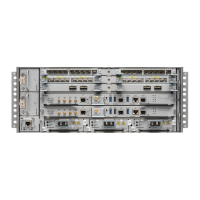The hello-password command can be used to prevent adjacency formation with unauthorized or undesired
routers. This ability is particularly useful on a LAN, where connections to routers with which you have no
desire to establish adjacencies are commonly found.
SUMMARY STEPS
1. configure
2. router isis instance-id
3. log adjacency changes
4. interface type interface-path-id
5. hello-padding { disable | sometimes } [ level { 1 | 2 }]
6. hello-interval seconds [ level { 1 | 2 }]
7. hello-multiplier multiplier [ level { 1 | 2 }]
8. h ello-password { hmac-md5 | text } { clear | encrypted } password [ level { 1 | 2 }] [ send-only
]
9. commit
10. show isis [ instance instance-id ] adjacency t ype interface- path-id ] [ detail ] [ systemid
system-id ]
11. show isis adjacency-log
12. show isis [ instance instance-id ] interface [ type interface-path-id ] [ brief | detail ] [ level { 1
| 2 }]
13. show isis [ instance instance-id ] neighbors [ interface-type interface-instance ] [ summary ] [
detail ] [ systemid system-id ]
DETAILED STEPS
PurposeCommand or Action
configure
Step 1
Enables IS-IS routing for the specified routing instance,
and places the router in router configuration mode.
router isis instance-id
Example:
Step 2
• You can change the level of routing to be performed
by a particular routing instance by using the is-type
command.
RP/0/RP0/CPU0:router(config)# router isis isp
Generates a log message when an IS-IS adjacency changes
state (up or down).
log adjacency changes
Example:
Step 3
RP/0/RP0/CPU0:router(config-isis)# log adjacency
changes
Enters interface configuration mode.
interface type interface-path-id
Example:
Step 4
RP/0/RP0/CPU0:router(config-isis)# interface
GigabitEthernet 0/1/0/3
Configures padding on IS-IS hello PDUs for an IS-IS
interface on the router.
hello-padding { disable | sometimes } [ level { 1 | 2
}]
Step 5
Routing Configuration Guide for Cisco NCS 6000 Series Routers, IOS XR Release 6.4.x
228
Implementing IS-IS
Tuning Adjacencies for IS-IS

